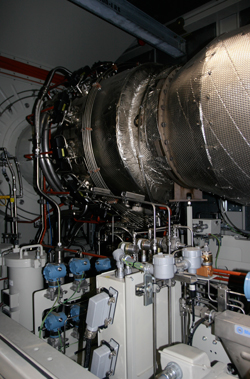Cogen Power: So Hot It's Cool
Cogen Power: So Hot It's Cool

Starting this fall, two jet engines will roar on campus but don't bother looking for a pilot, a crew, even a plane.
In fact, don't even listen for the roar.
The high-tech turbines, built by a division of Caterpillar Corp., form the heart of Rowan University's all-new cogeneration energy plant.
Housed in heavy, sound-dampening cabinets, the engines drive a $12 million facility that may be the crown jewel in a campus-wide effort to be more green.
John Imperatore, director of facilities and resource management, said the growing environmental movement at Rowan includes an active student recycling team, top-tier placement in Recyclemania (an annual nationwide campus competition), and a directive from the President's office for the university to reduce waste materials and cut emissions.
"Sustainability is more about what we do than simply buying a system," Imperatore said. "Our total recyclables were about 125 tons last year. About 13 percent of the trash stream was removed and recycled."
He said on-going recycling efforts are bolstered by special events like the annual "Move-In Cardboard Capture" and a university requirement that parade float materials be recycled.
But the biggest, most dramatic sign to date that Rowan is serious about getting carbon neutral - limiting the amount of waste it puts in the air and on the earth - must be the construction of the new cogen plant, a vast generator of electricity and steam.
Homegrown Superpower
Once operational (the larger of two units is expected to go online in October and the smaller by January) the plant will produce 4.7 megawatts of electricity, enough to power some 1,300 homes. Exhaust from the engines - pure, raw heat - will be harnessed to make up to 25,000 pounds of steam per hour for heating, hot water and air conditioning across campus.
Producing vast quantities of energy efficiently on campus, as opposed to buying it from old, inefficient utility plants, makes good sense, Imperatore said.
"Historically, the model was to produce power at giant plants and distribute it over long distances," he explained. "Well, there are losses along those distances. By generating it locally and more efficiently we're eliminating those losses."
Imperatore said the single act of building a high-efficiency cogen plant brings the university 30 percent closer to reaching its overall goal of restricting greenhouse gas emissions.
"It enables us to cut emissions by approximately 8,000 tons per year," he said. "It's the equivalent of planting 1.1 million trees, or taking 1,139 cars off the road, which is staggering."
Green, by the way, is also the color of money
Imperatore said construction of the new plant (which replaces a smaller, less efficient model) qualifies Rowan for a $1 million rebate from the state Board of Public Utilities and should facilitate energy savings of up to $1 million per year.
And, because it can run on either natural gas or #2 heating oil, Rowan can choose the least costly fuel available.
"That's an economic benefit primarily but also a reliability benefit," said Dr. Peter Jansson, a Rowan associate professor of electrical and computer engineering. "If they cut off the supply of natural gas we can switch over to fuel oil."
Echoing Imperatore, Jansson said the beauty of the plant is its efficiency.
"You typically don't think of burning fuel as contributing to emissions reduction but when we burn fuel to create electricity and steam there's a higher efficiency. You still burn a certain amount of natural gas (or fuel oil) but you create electricity in an environmentally friendly way. Then you use the heat that comes from it to make steam and run a steam powered chiller."
So hot it's cool
The plant's steam-powered chiller cools water to 45 degrees and that water passes through insulated pipes for air conditioning at roughly two thirds of the buildings on campus.
The upshot? Heat that could have been wasted from the jet engines gets captured and harnessed to warm buildings in the winter and cool them in the summer with no additional strain on the environment.
"This is just one of the steps we're taking toward becoming carbon neutral," Jansson said.
Other steps include the installation of solar panels on the team house roof to capture photovoltaic energy, efforts to develop ethanol-producing super bugs in biology labs and an ever growing emphasis on recycling.
Both Jansson and Imperatore credit Rowan President Donald Farish with leading the green brigade. Farish, who signed a pledge in April to cut greenhouse gas emissions across campus, was among 148 college presidents nationwide who signed the American College and University Presidents Climate Commitment and the first to do so in New Jersey.
"Over the next three years a plan will be created to make the campus climate neutral," Jansson said. "We'll use energy but have no impact on the environment. It's a lofty, lofty goal but Don Farish believes if we don't do that we're not doing our part in society."
Follow the link to our full "R.U. Green" section, complete with additional stories and ways in which Rowan University is living la vida verde: